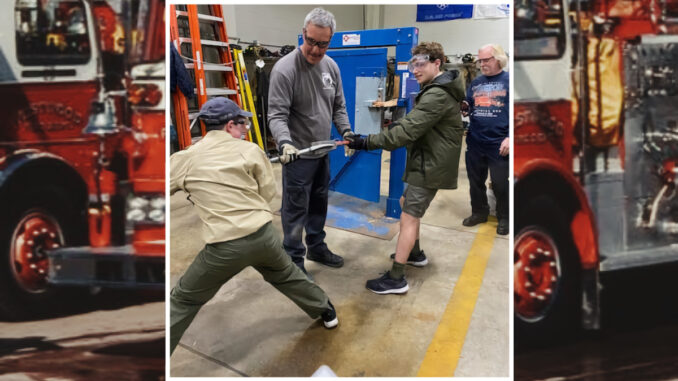
WESTWOOD—When seconds mean the difference between life and death, you need the right tools for the job — you also need people well trained in those tools’ use — not just the how, but the why and when.
Do you want to destroy the door or leave it serviceable as an ally? This is wrenching work, but also subtle.
The Westwood Fire Department had the pleasure recently of hosting Boy Scouts from Troop 350 to get a taste of the drilling firefighters build into muscle memory.
For firefighters, forcible entry is the tactic where entry to a locked building is gained amid an emergency: a fire, people trapped, a gas leak, etc.
Attending this drill satisfies one of scouts’ requirements toward earning an emergency preparedness merit badge, a vital stop on the path to Eagle Scout.
The drill was conducted by FDNY Lt. Michael Ciampo, who teaches forcible entry and other life- and property-saving techniques to New York City firefighters and writes in trade publications.
According to Bill Quinn, a Westwood firefighter since 1982, “Part of the lesson is that fire crews only use as much force as the situation warrants. If there is a serious fire burning and/or people are trapped where seconds count, firefighters will gain entry with whatever means is necessary.”
He said, “If there is no obvious fire, we will use less destructive tactics and possibly wait for a key holder.”
He explained “A mock-up of a steel door is used to simulate a door in a building. During the drill, two scouts were selected to try forcing the door. This drill is very valuable for the department so we keep our firefighting skills current.”
Chief James Voorhis told Pascack Press on April 13 that working with young people from the community is “very enjoyable; it’s encouraging actually, because this is our youth — our future, and it’s nice to have them work with us, you know what I’m saying? Our doors are always open for that.”
He said, “We assist them in Eagle Scout projects and stuff like that. We always have open houses — there’s always the Girl Scouts as well — and they come and tour the fire department. And we get them from all ages.”
Voorhis, whose family has well served the volunteer department, said having this group of scouts attend the drill is heartwarming, as “it’s one of the first times I’ve seen that in a long time, which is good, because they get all kinds of experience in seeing what we train on and what we do.”
The department drills on much, including ladders, proper building walkthroughs, extrication from motor vehicles — “we get junk cars and we cut them up with our tools” — and, at least once or twice a year, live structure burn training at Bergenfield Training Center or the Bergen County Fire Academy in Mahwah.
Voorhis said the borough is not seeing much drama with activity lately. “A lot of carbon monoxide alarms… Thank God we haven’t had any real major fires in recent times, but we’re on a steady pace; we’re keeping up with it.”
He said, “It’s heartwarming to see everybody get together again. And we do it safely — we still practice the Covid rules, whatever the CDC says and the borough policy is: we follow it.”
Lt. Ciampo’s bio says he is a 33-year veteran of the fire service. Previously, he served with the District of Columbia Fire Department. He has a bachelor’s degree in fire science from John Jay College of Criminal Justice in New York City. He is the lead instructor for the FDIC International Truck Essentials H.O.T. program. He wrote the Ladders and Ventilation chapters for “Fire Engineering’s Handbook for Firefighter I and II” (Fire Engineering, 2009) and the “Bread and Butter Portable Ladders” DVD and is featured in “Training Minutes” truck company videos. He writes for “Fire Engineering.”
One of the articles there, by Chief Fred LaFemina, a 21-year veteran of the FDNY, explains the history of the Halligan bar, the multi-tool that Troop 350’s scouts were drilling with for that forcible entry simulation at Westwood Fire Headquarters.
LaFemina says in part, “Forcible entry is a lost art. I believe members of the fire service need to get back to basics to rediscover it.”
He says, “Remember, we are mission oriented and will do whatever it takes to get the job done — safely. The irons (ax & halligan) are not accessories for your gear to make you look fashionable — they are the tools that allow firefighters to accomplish many tasks when needed. When that rabbit tool craps out, you always have the old failsafe system of the irons. So learn and be proficient in using them.”
He advises, “Forcible entry relies on physics, a science that involves the fundamental laws of the universe. It deals with the elementary constituents of the universe — matter, energy, space and time and their interactions.”
LaFemina says, “Although physics has a lot to do with forcible entry, I realize this is not on your mind when you are enveloped in thick, black and acrid smoke, trying to force a door. But this definition shows a relationship between science and the fire service.”
